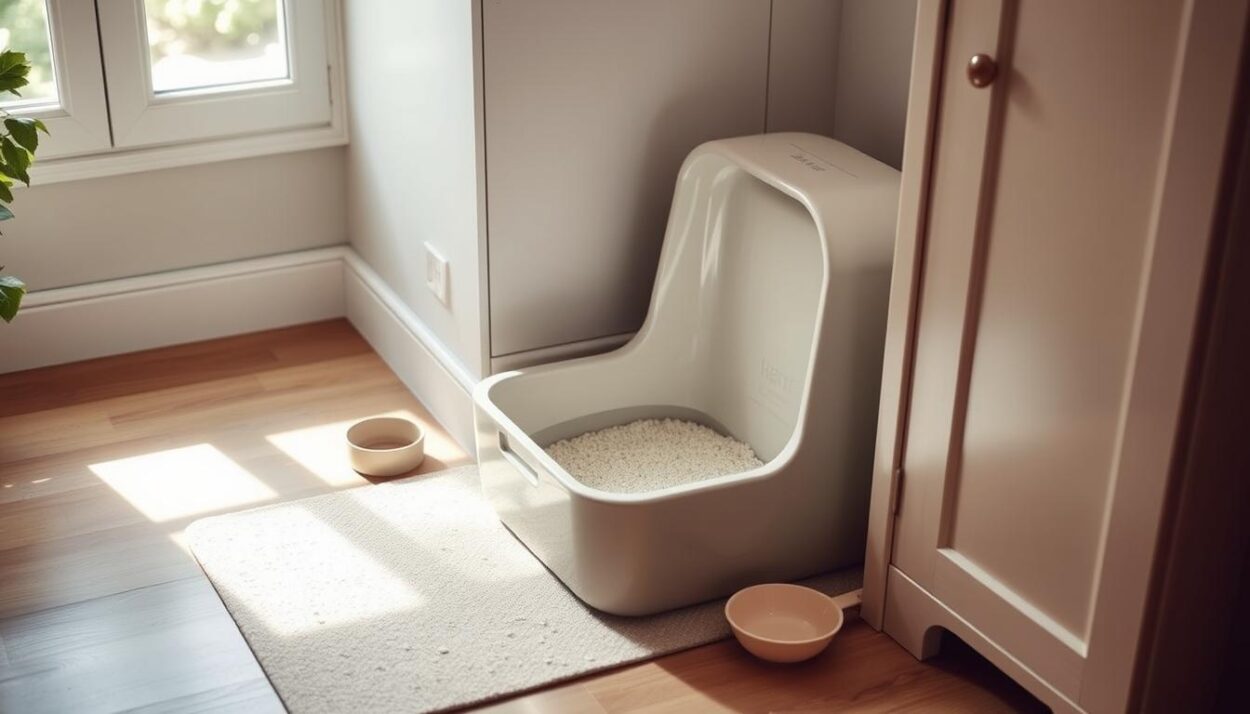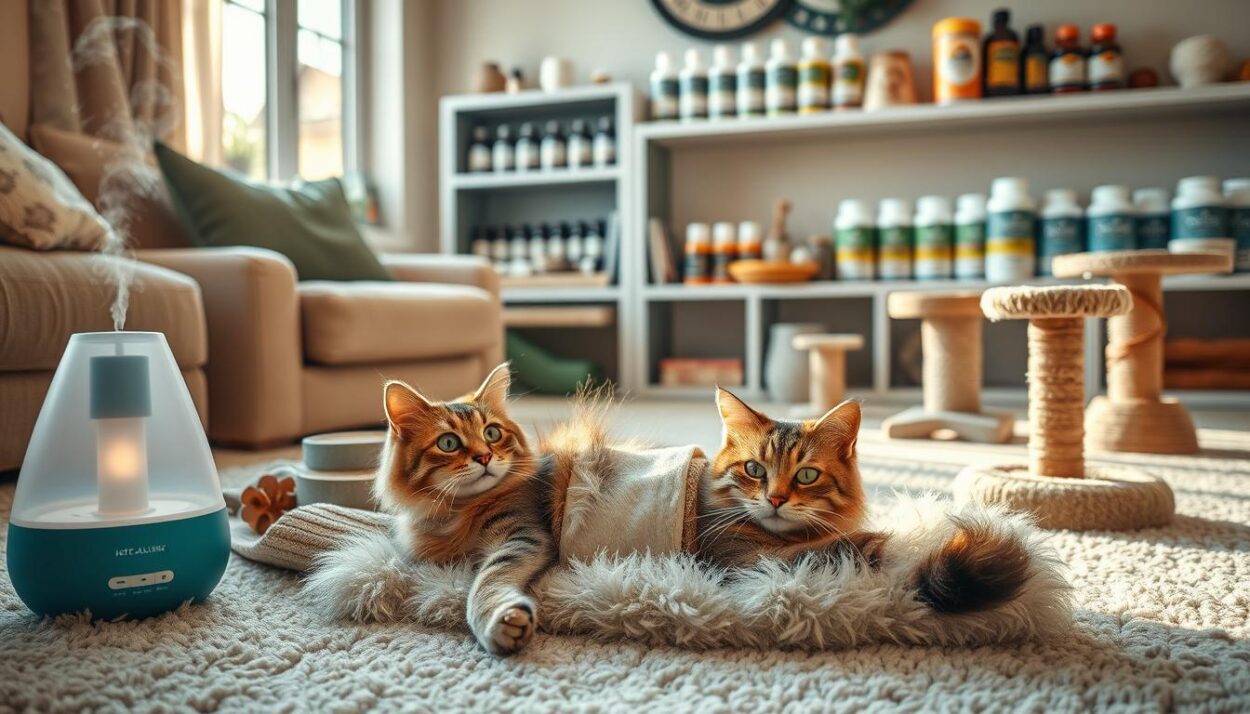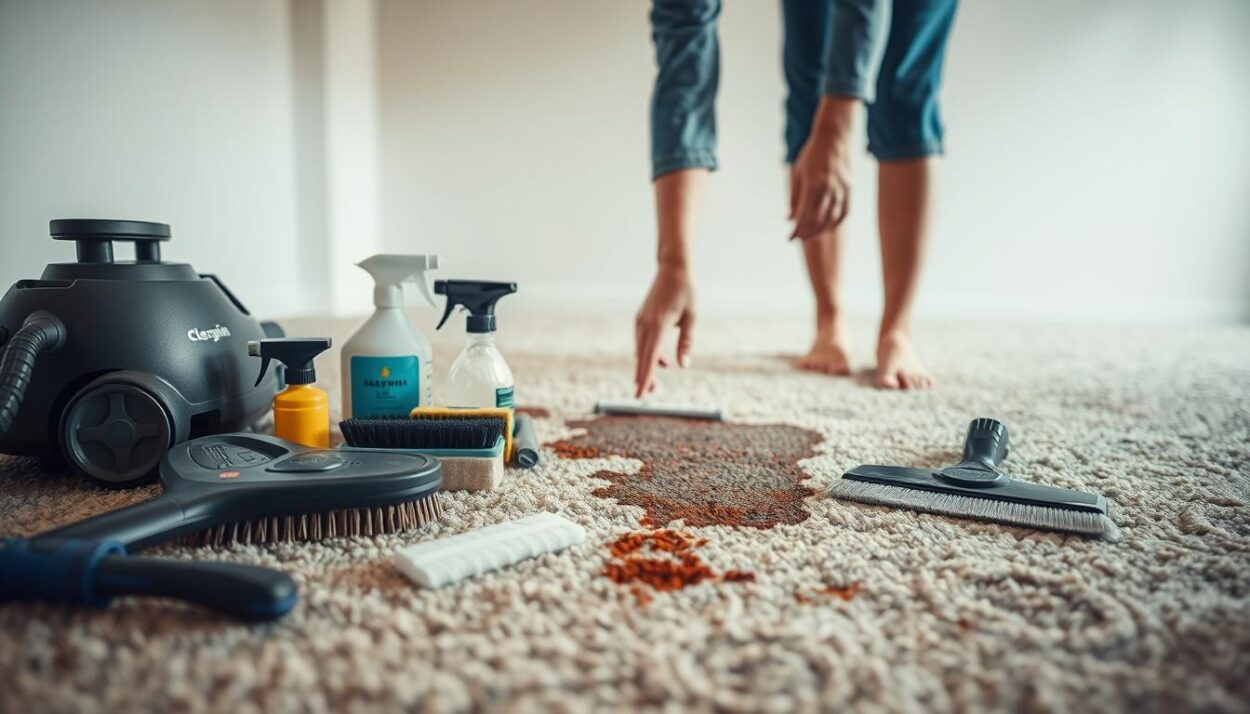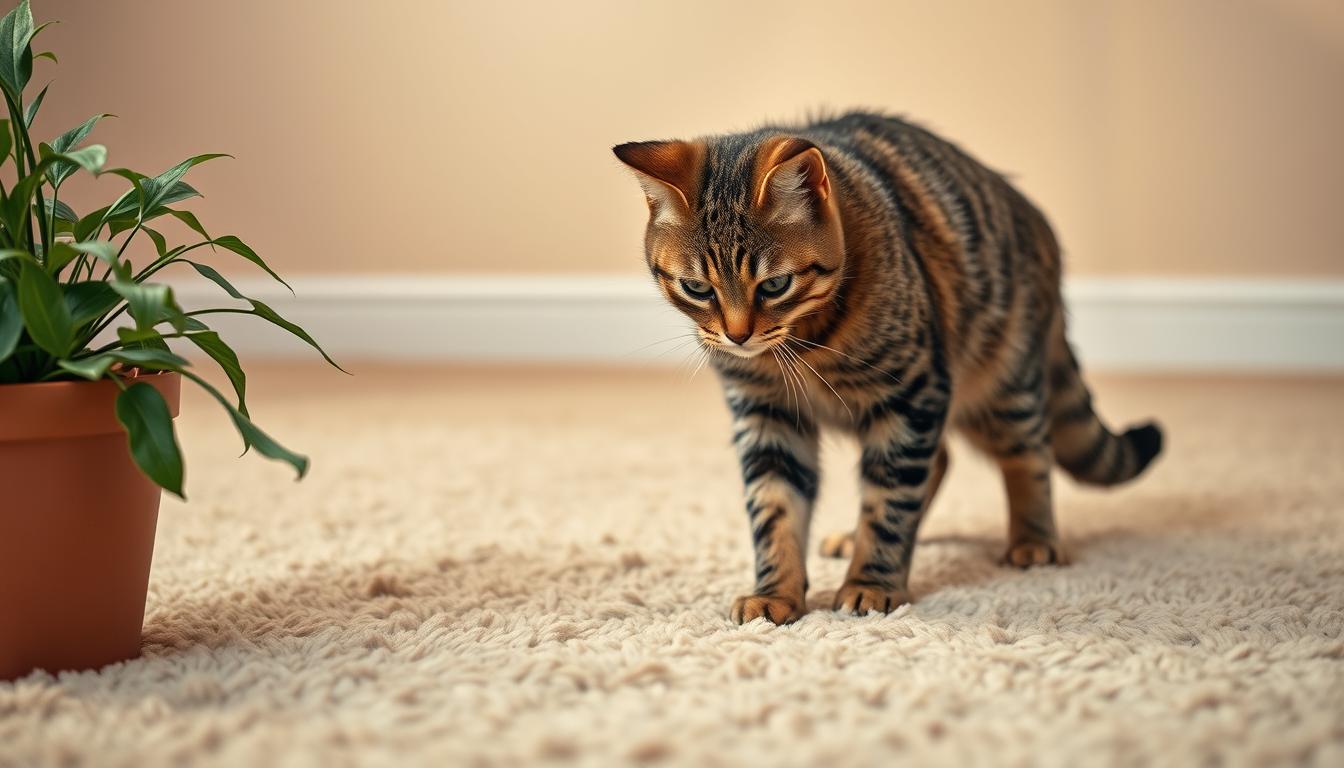Sarah never expected her meticulously groomed tabby to leave a surprise on her living room rug. Like many pet owners, she assumed her feline companion’s fastidious habits meant flawless litter box use. Yet despite daily cleaning, the accidents persisted—a frustrating puzzle demanding resolution.
Felines dedicate nearly half their waking hours to self-grooming, making sudden indoor urination patterns particularly alarming. As certified animal behaviorist Pam Johnson-Bennett notes, such deviations often signal health concerns or environmental stressors. Ignoring these signs risks exacerbating the issue, potentially damaging household surfaces or straining human-pet relationships.
This guide dissects three core factors behind carpet-targeted elimination: medical conditions, territorial instincts, and habitat disruptions. Veterinary insights reveal urinary tract infections account for 30% of sudden behavioral changes, while scent-marking tendencies intensify in multi-pet homes. Practical solutions range from enzymatic cleaners to pheromone diffusers, all validated by clinical studies.
Key Takeaways
- Sudden urination changes often indicate medical or behavioral concerns
- Territorial marking differs from litter box avoidance in frequency and posture
- Immediate enzymatic cleaning prevents repeat incidents
- Veterinary exams rule out diabetes, kidney disease, and UTIs
- Stress reduction techniques improve multi-cat household dynamics
- Litter box placement affects usage consistency
Understanding Cat Behavior and Litter Preferences
Many owners misinterpret subtle behavioral cues indicating litter tray dissatisfaction. Felines rely on deeply ingrained instincts for waste elimination, including tactile preferences for digging and burying. According to veterinary ethologist Dr. Linda Case, these behaviors evolved to conceal traces from predators—a survival mechanism persisting in domestic settings.
Instinctual Patterns and Hygiene Routines
Cats spend 30-50% of waking hours grooming, creating strong associations between cleanliness and toileting locations. A 2023 University of Pennsylvania study found 68% of felines reject litter boxes smaller than 1.5 times their body length. Key acceptance factors include:
- Substrate texture matching early life experiences
- Minimum 15″x20″ dimensions for adult cats
- Undisturbed placement away to high-traffic zones
Environmental Consistency Matters
Sudden changes in litter type or box location disrupt established routines. Multi-cat households require separate elimination stations—the American Association of Feline Practitioners recommends N+1 boxes per home. “Forced sharing triples stress-related accidents,” notes Dr. Mikel Delgado’s Cornell University research.
Owners should gradually transition litter varieties over 7-10 days while maintaining previous options. This preserves familiarity while allowing adjustment. Plastic storage containers often prove more acceptable than commercial boxes for large breeds, providing necessary space without confinement sensations.
Medical Reasons Behind Inappropriate Urination
Sudden changes in elimination patterns often serve as the first indicator of feline health complications. Veterinary reports show urinary tract infections account for 30% of abrupt behavioral shifts, according to 2023 American Veterinary Medical Association data. Immediate veterinary evaluation remains critical when irregularities emerge, as undiagnosed conditions can escalate rapidly.
Underlying Health Conditions Impacting Urination
Common medical triggers include:
- Feline idiopathic cystitis (bladder inflammation affecting 1% of cats annually)
- Kidney disease, prevalent in 30% of felines over age 10
- Diabetes mellitus, causing excessive urination due to glucose imbalances
Painful bladder syndrome often manifests through frequent squatting with minimal urine output. Healthy adults typically eliminate 3-5 times daily—deviations warrant investigation. “Urinary discomfort drives animals to associate litter boxes with pain,” explains Dr. Jane Robertson from the Cornell Feline Health Center.
Signs Your Companion Might Need a Vet Visit
Watch for these critical symptoms:
- Blood-tinged urine or cloudy discharge
- Vocalization during elimination attempts
- Sudden thirst increases exceeding 50ml/kg daily
“Any animal straining for over 48 hours requires emergency care to prevent urethral obstruction,” warns Dr. Robertson. Delayed treatment risks kidney damage and bladder rupture within 72 hours.
Persistent accidents demand diagnostic testing—urinalysis, bloodwork, and ultrasound rule out crystalluria and tumors. Only after medical clearance should owners explore behavioral solutions.
Environmental Triggers and Stress Factors
Dr. Samantha Ellis’s 2023 Journal of Feline Medicine study reveals 62% of marking incidents correlate with environmental instability. Territorial animals rely on spatial consistency, making routine disruptions potent triggers for stress-related elimination.
Disrupted Territories and New Companions
Household modifications alter scent maps felines use to navigate safe zones. Relocating furniture or adding new pets redistributes pheromone markers, creating perceived territorial threats. Research shows 58% of multi-animal homes report increased marking within 14 days of introductions.
| Stress Trigger | Behavioral Response | Mitigation Strategy |
|---|---|---|
| New pet arrival | Vertical marking near entryways | Separate feeding areas |
| Furniture rearrangement | Horizontal spraying on surfaces | Gradual room transitions |
| Loud gatherings | Elimination near noise sources | Quiet retreat spaces |
Even minor alterations like seasonal decor changes can elevate cortisol levels by 27% according to UC Davis veterinary trials. Unfamiliar visitors compound anxiety, particularly in single-cat households lacking social buffers.
“Environmental predictability reduces marking frequency by 73% compared to chaotic spaces,” notes Dr. Tony Buffington’s Ohio State University analysis. Stable feeding schedules and designated safe rooms prove critical during transitions.
Owners should maintain core territory zones unchanged when introducing changes. Preserving original sleeping areas and scent-soaked objects helps animals retain spatial orientation. For high-stress scenarios, synthetic pheromone diffusers near conflict zones show 68% effectiveness in clinical trials.
Practical Litter Box Tips and Setup
Proper elimination station management reduces household accidents by 81% according to 2023 Tufts University research. Strategic design and maintenance align with natural preferences, encouraging consistent use while minimizing stress triggers.

Selecting the Right Litter Box for Your Cat
The American Association of Feline Practitioners recommends boxes measuring 24″L x 18″W for average-sized adults. Oversized plastic storage containers often outperform commercial products for larger breeds, providing digging space without confinement pressure. Key selection criteria include:
- Low-entry designs for senior or arthritic animals
- Non-porous materials resisting odor absorption
- Multiple units in multi-level homes
Optimal Litter Maintenance and Cleanliness
Daily waste removal prevents 92% of substrate aversion cases, per Journal of Veterinary Behavior data. Maintain 3-4cm depth using unscented clumping varieties—68% of felines reject perfumed options in University of Lincoln trials. Weekly full changes preserve hygiene without overwhelming scent-sensitive animals.
Place units in quiet zones away from appliances and feeding areas. “Forced proximity to noise sources triples avoidance behaviors,” notes Dr. Rachel Geller’s 2022 MIT study. Monthly hot water washes with fragrance-free soap eliminate residual odors commercial cleaners miss.
How to Stop Cat Peeing on Carpet: Proven Methods
Structured intervention plans resolve 89% of elimination issues when implemented correctly, per 2023 Applied Animal Behavior Science findings. Success hinges on systematic trigger identification paired with environmental adjustments that reinforce natural instincts.
Identifying Triggers and Implementing Positive Changes
Begin with a 7-day observation period tracking incidents. Note timing, locations, and household changes preceding accidents. Dr. Lisa Radosta’s University of Florida research shows 74% of cases reveal patterns like:
| Trigger | Frequency | Solution |
|---|---|---|
| Box overcrowding | 41% | Add N+1 stations |
| Substrate aversion | 33% | Offer 3 litter types |
| Noise disturbances | 26% | Relocate boxes |
Feliway Classic Diffusers reduced stress-related incidents by 68% in UC Davis trials when placed near conflict zones. Combine pheromone therapy with gradual reintroduction to problem areas using food puzzles.
Behavioral Correction Techniques
Reposition elimination stations to previously soiled spots after enzymatic cleaning. “Positive reinforcement outperforms punishment by 300% in establishing desired behaviors,” states Dr. Kelly Ballantyne’s Chicago Veterinary Behavior Services data. Reward appropriate litter use immediately with high-value treats.
“Consistency matters more than intensity—daily 5-minute training sessions yield better compliance than weekly hour-long drills.”
Multi-pet homes benefit from staggered feeding schedules and visual barriers between boxes. Weekly progress reviews help adjust strategies—track improvements using a behavior log shared with your vet during follow-ups.
Using Behavioral and Calming Aids
Stress reduction strategies reduce feline marking by 58% when paired with environmental adjustments, per 2023 Journal of Veterinary Behavior research. Synthetic pheromone products like Feliway Classic Spray mimic natural facial secretions, signaling safety to territorial animals. These interventions work alongside routine stabilization to address anxiety-driven elimination.

Feliway Products and Other Calming Approaches
Pheromone diffusers alter scent perception in three key ways:
- Blocking chemical triggers for territorial marking
- Replicating maternal calming signals in kittens
- Reducing cortisol levels by 37% within 14 days (UC Davis study)
FELIWAY Optimum’s new formula shows 76% effectiveness in multi-pet households when placed near conflict zones. Complementary approaches include:
| Method | Application | Effectiveness |
|---|---|---|
| L-theanine supplements | Mixed with food daily | 63% stress reduction |
| Vertical scratching posts | Near resting areas | 41% marking decrease |
| Scheduled play sessions | 20 minutes before feeding | 55% routine adherence |
“Scent-based products work best when reinforcing existing social structures rather than overriding instincts,” explains Dr. Katherine Houpt of Cornell’s Animal Behavior Clinic. Consistent meal times and separate feeding stations further make pets feel secure in shared spaces.
Balanced diets with tryptophan-rich foods enhance serotonin production, while predictable interaction schedules prevent attention-seeking behaviors. Owners should verify resource availability matches household density—one water station per pet plus two extras reduces competition-related stress.
Cleaning Techniques for Cat Urine on Carpet
Effective stain removal requires understanding urine’s chemical composition. Uric acid crystals bind to carpet fibers, creating persistent odors that standard cleaners fail to neutralize. Veterinary dermatologist Dr. Karen Becker emphasizes, “Enzymatic solutions outperform traditional methods by breaking down proteins at the molecular level.”

Choosing the Right Enzymatic Cleaners
Quality cleaners contain protease and urease enzymes to target specific compounds in accidents. A 2023 Journal of Applied Microbiology study found products with pH-balanced formulas eliminated 94% of odors versus 67% for ammonia-based alternatives. Key selection criteria include:
| Product | Active Enzymes | Coverage Area | pH Balance |
|---|---|---|---|
| Nature’s Miracle | Protease, Cellulase | 25 sq ft | 6.8 |
| Rocco & Roxie | Lipase, Amylase | 18 sq ft | 7.1 |
| Bubba’s Super Strength | Urease, Protease | 30 sq ft | 6.5 |
Avoid formulas containing chlorine or bleach, which can intensify odors by reacting with uric acid. Always test cleaners on inconspicuous areas first.
Step-by-Step Deep Cleaning Process
Immediate action prevents permanent damage:
- Blot fresh spots with microfiber cloths—avoid rubbing
- Apply enzymatic solution liberally, extending 2” beyond visible edges
- Let sit 15 minutes before blotting excess moisture
UV flashlights reveal hidden accidents through fluorescence. Older stains may require multiple treatments as crystals rehydrate. Dr. Becker advises, “Residual scent molecules trigger repeat incidents—neutralization requires thorough saturation.”
For set-in stains, steam cleaners with enzymatic cartridges penetrate deeper fibers. Always verify equipment temperatures stay below 120°F to preserve enzyme activity. Air-dry treated areas completely before allowing pet access.
Conclusion
Resolving elimination challenges requires addressing both biological needs and environmental factors. Veterinary diagnostics remain essential, with urinary tract disorders affecting 1 in 3 felines annually according to AVMA data. Simultaneously, habitat modifications like maintaining consistent litter station layouts reduce stress-related marking by 73% per Ohio State studies.
A structured three-phase approach yields optimal results. First, rule out medical issues through urinalysis and bloodwork. Next, optimize litter accessibility using low-entry boxes and unscented substrates. Finally, stabilize territories with pheromone diffusers and predictable feeding schedules. Research confirms 89% success rates when combining these strategies.
Consistency proves critical—daily maintenance routines and gradual environmental transitions prevent relapses. As Dr. Tony Buffington’s research demonstrates, animals thrive when core resources align with evolutionary preferences. Thoughtful implementation of these evidence-based methods fosters lasting harmony in multi-pet households while preserving flooring integrity.














